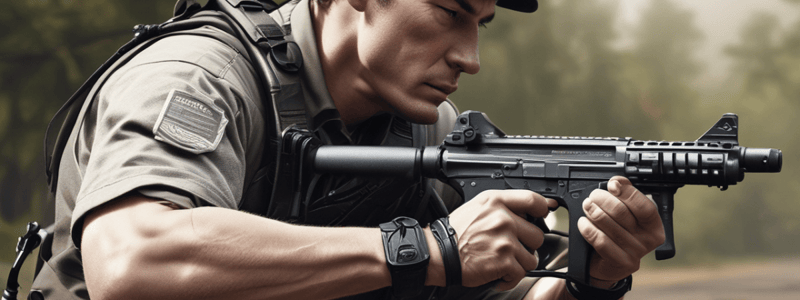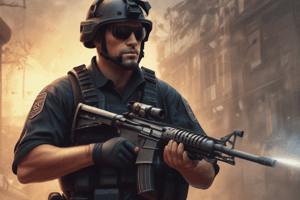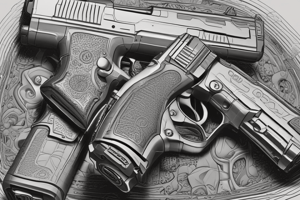Podcast
Questions and Answers
What is the primary consideration in the training environment of the Nightfire Handgun Shotgun course?
What is the primary consideration in the training environment of the Nightfire Handgun Shotgun course?
- Safety (correct)
- Speed
- Operator awareness
- Accuracy
What is the minimum distance from which the courses will be fired in most ranges?
What is the minimum distance from which the courses will be fired in most ranges?
- Ten yards
- Five yards
- One yard
- Three yards (correct)
What is the emphasis of the Nightfire training course?
What is the emphasis of the Nightfire training course?
- Decision-making process
- Stress combat-type courses
- Officer survival tactics
- Target identification and firing discipline (correct)
What should operators do with their finger while handling a firearm?
What should operators do with their finger while handling a firearm?
What is the purpose of discussing the effects of light in the Nightfire training course?
What is the purpose of discussing the effects of light in the Nightfire training course?
What is the correct way to point the muzzle of a firearm?
What is the correct way to point the muzzle of a firearm?
What is the correct procedure for handling a firearm?
What is the correct procedure for handling a firearm?
What is the fourth critical safety rule in handling a firearm?
What is the fourth critical safety rule in handling a firearm?
What is the primary purpose of yelling 'malfunction' during dim-light shooting exercises?
What is the primary purpose of yelling 'malfunction' during dim-light shooting exercises?
When is it acceptable to move from your shooting station?
When is it acceptable to move from your shooting station?
What is the purpose of the 'CEASE FIRE' command?
What is the purpose of the 'CEASE FIRE' command?
What should a shooter do if they do not wish to fire a particular round?
What should a shooter do if they do not wish to fire a particular round?
Why is wearing a head cover recommended?
Why is wearing a head cover recommended?
What should a shooter do if they do not understand a range command?
What should a shooter do if they do not understand a range command?
What does the 'LOAD' command instruct the shooter to do?
What does the 'LOAD' command instruct the shooter to do?
What is the purpose of the 'AT EASE' command?
What is the purpose of the 'AT EASE' command?
What is the primary purpose of the 'IS THE LINE SAFE?' phrase?
What is the primary purpose of the 'IS THE LINE SAFE?' phrase?
Why is dry firing allowed only on the firing line under the supervision of an instructor?
Why is dry firing allowed only on the firing line under the supervision of an instructor?
What is the primary reason for treating all guns as if they are loaded?
What is the primary reason for treating all guns as if they are loaded?
What is the immediate purpose of discharging a firearm at any person?
What is the immediate purpose of discharging a firearm at any person?
What should you do when a range instructor gives a command on the firearms range?
What should you do when a range instructor gives a command on the firearms range?
What should you check when handed a firearm?
What should you check when handed a firearm?
What is the purpose of a 'cold' range?
What is the purpose of a 'cold' range?
What should you do with a drawn firearm?
What should you do with a drawn firearm?
Why is smoking not allowed on the firing line?
Why is smoking not allowed on the firing line?
What should you do if you experience a misfire?
What should you do if you experience a misfire?
What is a 'hang fire'?
What is a 'hang fire'?
What should you do if you experience a 'squib fire' or 'squib load'?
What should you do if you experience a 'squib fire' or 'squib load'?
What is the primary benefit of the Harries method of flashlight technique?
What is the primary benefit of the Harries method of flashlight technique?
What is the recommended practice before engaging in live fire exercises?
What is the recommended practice before engaging in live fire exercises?
What is the primary concern during night time shootings?
What is the primary concern during night time shootings?
What is the purpose of using a flashlight motion side-to-side?
What is the purpose of using a flashlight motion side-to-side?
What is the recommended way to practice techniques?
What is the recommended way to practice techniques?
What is the worst hour for violent crimes?
What is the worst hour for violent crimes?
What is the primary benefit of night sights?
What is the primary benefit of night sights?
What is the tendency during night time shootings?
What is the tendency during night time shootings?
What is the purpose of the 'problem' signal?
What is the purpose of the 'problem' signal?
What is the recommended way to control the flashlight?
What is the recommended way to control the flashlight?
What is the primary concern during dim-light shooting exercises?
What is the primary concern during dim-light shooting exercises?
Why do officers tend to shoot high at night or in low light?
Why do officers tend to shoot high at night or in low light?
What is the purpose of off-centered vision in low light conditions?
What is the purpose of off-centered vision in low light conditions?
What affects the eyes' ability to adapt to night vision?
What affects the eyes' ability to adapt to night vision?
How long does it take to produce rod cells for night vision?
How long does it take to produce rod cells for night vision?
What is the primary reason for modifying day firing techniques in low light conditions?
What is the primary reason for modifying day firing techniques in low light conditions?
What is the result of focusing directly on an object in low light?
What is the result of focusing directly on an object in low light?
When can instinct shooting be used at night?
When can instinct shooting be used at night?
What is the primary function of the iris in the eye?
What is the primary function of the iris in the eye?
What is the term for the type of vision that occurs at night or in low light?
What is the term for the type of vision that occurs at night or in low light?
What is the primary technique used to align the sights when the target/suspect has a partial silhouette?
What is the primary technique used to align the sights when the target/suspect has a partial silhouette?
Why should an officer avoid centering the light on the target/suspect?
Why should an officer avoid centering the light on the target/suspect?
What is the recommended action after acquiring the target/suspect and aligning the sights?
What is the recommended action after acquiring the target/suspect and aligning the sights?
What is the primary benefit of using a flashlight in shooting situations?
What is the primary benefit of using a flashlight in shooting situations?
What is the recommended technique for using a flashlight when shooting from behind cover?
What is the recommended technique for using a flashlight when shooting from behind cover?
What is the primary consideration when selecting a flashlight for police duty?
What is the primary consideration when selecting a flashlight for police duty?
What is the key to mastering flashlight shooting techniques?
What is the key to mastering flashlight shooting techniques?
What is the primary benefit of using a flashlight in conjunction with a firearm?
What is the primary benefit of using a flashlight in conjunction with a firearm?
What is the recommended action after firing a shot?
What is the recommended action after firing a shot?
What is the primary characteristic of the Ayoob method of flashlight shooting?
What is the primary characteristic of the Ayoob method of flashlight shooting?
What is the most effective way to use a flashlight in a shooting situation?
What is the most effective way to use a flashlight in a shooting situation?
What is the primary consideration when selecting a flashlight for police duty?
What is the primary consideration when selecting a flashlight for police duty?
What is the key to mastering the use of a flashlight in shooting situations?
What is the key to mastering the use of a flashlight in shooting situations?
What is the benefit of using the vehicle as cover when using a flashlight in a shooting situation?
What is the benefit of using the vehicle as cover when using a flashlight in a shooting situation?
What is the FBI method of flashlight shooting?
What is the FBI method of flashlight shooting?
What is the key difference between the old and new FBI methods of flashlight shooting?
What is the key difference between the old and new FBI methods of flashlight shooting?
What is the Ayoob method of flashlight shooting?
What is the Ayoob method of flashlight shooting?
What is the primary benefit of using the Harries' method of flashlight shooting?
What is the primary benefit of using the Harries' method of flashlight shooting?
What is the Ray Chapman method of flashlight shooting?
What is the Ray Chapman method of flashlight shooting?
What is the primary reason why objects lack color in low light or dark conditions?
What is the primary reason why objects lack color in low light or dark conditions?
What is the primary advantage of using a flashlight in a shooting situation?
What is the primary advantage of using a flashlight in a shooting situation?
What is the effect of bright lights on night vision?
What is the effect of bright lights on night vision?
What is the principle of dark adaptation in night vision?
What is the principle of dark adaptation in night vision?
What is the technique of off-centered vision used for in night fire techniques?
What is the technique of off-centered vision used for in night fire techniques?
What is the purpose of using the light available from the face of the target/suspect in night fire techniques?
What is the purpose of using the light available from the face of the target/suspect in night fire techniques?
What is the correct technique for using silhouette light in night fire techniques?
What is the correct technique for using silhouette light in night fire techniques?
What is the purpose of using a flashlight in night fire techniques?
What is the purpose of using a flashlight in night fire techniques?
What should be done with the light after acquiring the target and aligning the sights?
What should be done with the light after acquiring the target and aligning the sights?
What is the purpose of instinct shooting in night fire techniques?
What is the purpose of instinct shooting in night fire techniques?
What is the primary reason for moving after shooting in night fire techniques?
What is the primary reason for moving after shooting in night fire techniques?
Study Notes
Night Fire Handgun Shotgun Training
Introduction
- Night fire training is designed to introduce trainees to realistic encounter times and light conditions.
- Emphasis on target identification and firing discipline.
Firearms Range Safety Rules and Guidelines
- Safety first: total operator awareness of the firearm at all times.
- Four critical safety rules:
- Treat all firearms as if they are loaded.
- Point the muzzle in a safe direction (down range) or at the target.
- Keep your finger outside of the trigger guard and off the trigger until on target and ready to fire.
- Always be sure of your target and aware of what is beyond the target.
- Additional safety rules:
- No smoking, eating, or drinking on the firing line.
- No alcohol or drug consumption.
- No talking on the firing line except by range instructors.
- Handguns must remain in holsters unless on the firing line.
- No magazine or ammunition in the weapon when carrying it on the range.
Range Commands
- LOAD: command to load the firearm.
- STAND BY: command to assume the starting position.
- READY: alert to the next command.
- FIRE: command to perform the string of fire.
- CEASE FIRE: command to stop firing immediately.
- GO FORWARD: command to move forward after the firing line is safe.
- HOLSTER: command to holster a safe weapon.
- UNLOAD: command to unload the firearm and complete a "condition check".
- AT EASE: command to stop a series of commands and await further instructions.
Dim-Light Shooting Considerations
- Most violent crimes occur at night or in low light conditions.
- Target identification is crucial.
- Firing discipline is critical in low light conditions.
- Light (or lack of it) affects the eyes in a predictable way.
- Depth perception is distorted in low light conditions.
- Day firing techniques need to be modified in low light conditions.
Night Vision and Techniques
- The eyes use cone cells in bright light and rod cells in low light.
- Vitamin A, exposure to bright lights, and certain conditions can affect night vision.
- Principles of night vision:
- Dark adaptation.
- Off-centered vision.
- Instinct shooting can be used at night.
- Night fire techniques:
- Using light on the face of the target/suspect.
- Using light behind the target/suspect (silhouette light).
- Using a flashlight to acquire the target and sights.
- Using light from vehicle strobes, rotators.
Flashlight Shooting Techniques
- Four basic styles:
- The FBI method (old and new).
- The Ayoob method.
- The Ray Chapman method.
- The Harries method.
- Considerations:
- Using the flashlight to acquire the target and sights.
- Turning off the light after firing.
- Moving after firing.
- Using the light to control the suspect.
- Practice is crucial to master flashlight shooting techniques.
Live Fire Procedures
- Will be determined by academy/department policy.
- Exercises to start with the gun holstered or drawn.
- Emphasis on safety and proper technique.### Night Fire Techniques
- Dim light or night time shootings require awareness of specific concerns:
- Majority of violent crimes occur at night or in low light conditions
- Worst hours are from 9 pm to 3 am, with the worst hour being 11 pm to 12 midnight
- Target identification is crucial
- Firing discipline is critical to avoid premature shooting and to cease firing when the target is no longer visible
Night Vision
- Light affects the eyes in a predictable way:
- Day firing techniques need to be modified in low light conditions
- Objects appear faint, lack sharpness, and lack color in low light
- Eye makeup and construction affect vision:
- Cone cells allow for color, shape, and contrast vision in bright light
- Rod cells produce "night vision" in low light, allowing for black and white, shades of gray, and general outlines
- Factors affecting night vision:
- Vitamin A deficiency
- Exposure to bright lights
- Colds, headaches, fatigue, narcotics, heavy smoking, and excessive alcohol use
- Principles of night vision:
- Dark adaptation takes about 30 minutes to produce rod cells
- Off-centered vision helps to focus on objects without staring directly
Instinct Shooting
- Instinct shooting (point shooting) can be used at night:
- Officer must be close enough to identify the suspect and justify the use of deadly force
- Proper foot positioning and body stance are necessary for center mass hits
Night Fire Techniques
- Using available light to acquire target acquisition and a sight picture:
- Light on the face of the target/suspect
- Light behind the target/suspect (using silhouette light)
- Using a flashlight to acquire the target and align the sights
- Light coming from vehicle strobes, rotators, or flashers
Flashlight Techniques
- Establishing a good flashlight shooting-grip technique:
- Use the light sparingly to identify the threat and to see the front sight
- Get the light off as soon as possible after acquiring the target
- Move after firing, if possible
- Four flashlight shooting techniques:
- The FBI method (old and new)
- The Ayoob method
- The Ray Chapman method
- The Harries' method
Studying That Suits You
Use AI to generate personalized quizzes and flashcards to suit your learning preferences.
Description
This lesson plan covers night fire training, introducing trainees to realistic encounter scenarios and light conditions. It's a continuation of stress combat-type courses emphasizing officer survival tactics and decision-making.



